What Is a Market Analysis?
A market analysis is a detailed assessment that helps a business understand its target market and the competitive landscape within its industry. Which enables them to make smarter business decisions.
And it involves evaluating factors like market size, market growth, trends, customer needs, and potential opportunities.
Why Is Conducting a Market Analysis Important?
Here are a few of the main benefits of doing a market analysis:
Identify and Validate Product-Market Fit
A market analysis can help you determine if there’s enough demand for your product or service. And how your solution can solve your target customers’ problems better than anyone else.
Doing this can help you avoid wasting time and resources on developing something nobody wants or needs.
Define a Unique Value Proposition
A market analysis can also help you stand out from the crowd.
It can reveal your competitors’ strengths and weaknesses. And what makes your offer different and better.
By defining your unique value proposition, you can communicate your benefits clearly and persuasively to your prospects. And gain a competitive edge in the market.
Segment Your Target Audience
Conducting a market analysis can help you divide your target audience into smaller and more specific groups. Based on their traits, behaviors, and preferences.
Then, you can create buyer personas that represent your ideal customers. And understand their pain points, goals, motivations, and challenges.
Like this:
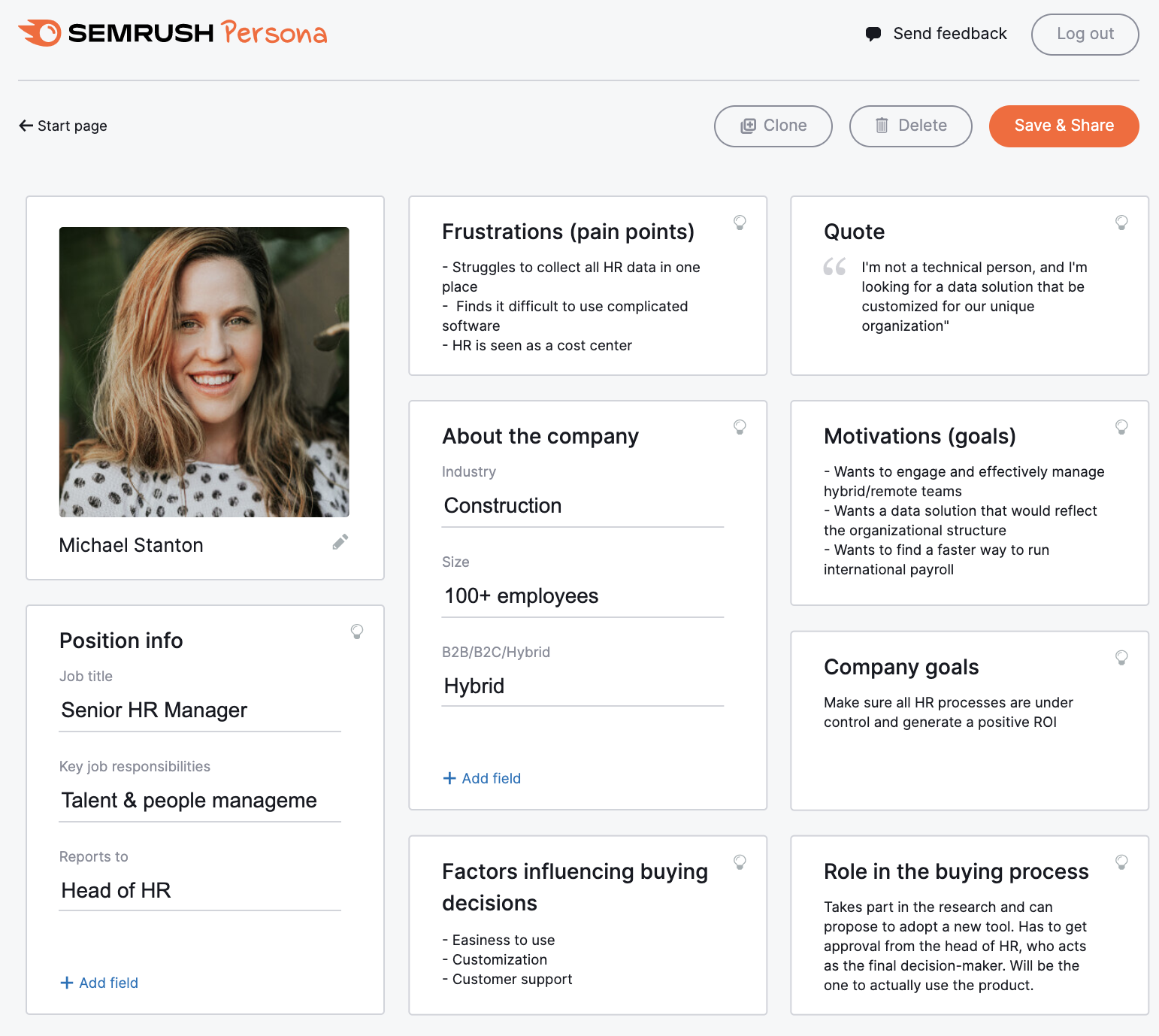
This way, you can tailor your marketing messages and strategies to each group. And boost your conversions.
Develop an Effective Marketing Strategy
A market analysis helps you create an effective marketing strategy that aligns with your business goals and objectives.
It can reveal the best channels, tactics, and tools to reach your target audience. And how to optimize your marketing budget and resources.
Meaning it can help you develop a strategy that leads to more traffic, leads, sales, and revenue.
Monitor and Adapt to Changing Market Conditions
Finally, a market analysis can also help you monitor and adapt to changing market conditions and customer needs.
It tracks trends, opportunities, and threats in your niche. And how they affect your business performance.
It also collects feedback and data from your customers. And helps you leverage it to improve your product or service.
Doing both allows you to stay ahead of the curve and hold your market position.
How to Do a Market Analysis
Let’s explore how to do market analysis. Step by step.
1. Define Your Goals & Objectives
The first step of doing a market analysis is to define the specific and measurable outcomes you want to achieve from your market analysis.
Doing this can help you focus your analysis on the most important aspects of your market. And evaluate your success at the end.
For example, some common goals and objectives for a market analysis are to:
- Identify and quantify the target market’s size, growth, and potential
- Understand and segment customer needs, preferences, and behavior
- Find out who your main competition is and how they position themselves
- Discover and emerging market opportunities you can capitalize on
- Develop and test your product or service value proposition and marketing strategy
Further reading: How to Align Business and SEO Goals for Long-Term Success
2. Research the Market’s Size, Trends, and Dynamics
The second step is to research your market’s size, trends, and dynamics. Because they’re the key indicators of your market’s current and future potential.
The best way to get this information is to use a tool like Market Explorer.
Select “Analyze Category,” choose a location, choose your business category, and click “Research a market.”

The tool will gather data for the top 1,000 domains within your industry. And provide a bird’s eye view of the market.
You’ll see the total market size, market value, level of consolidation within the market, key players, and more.
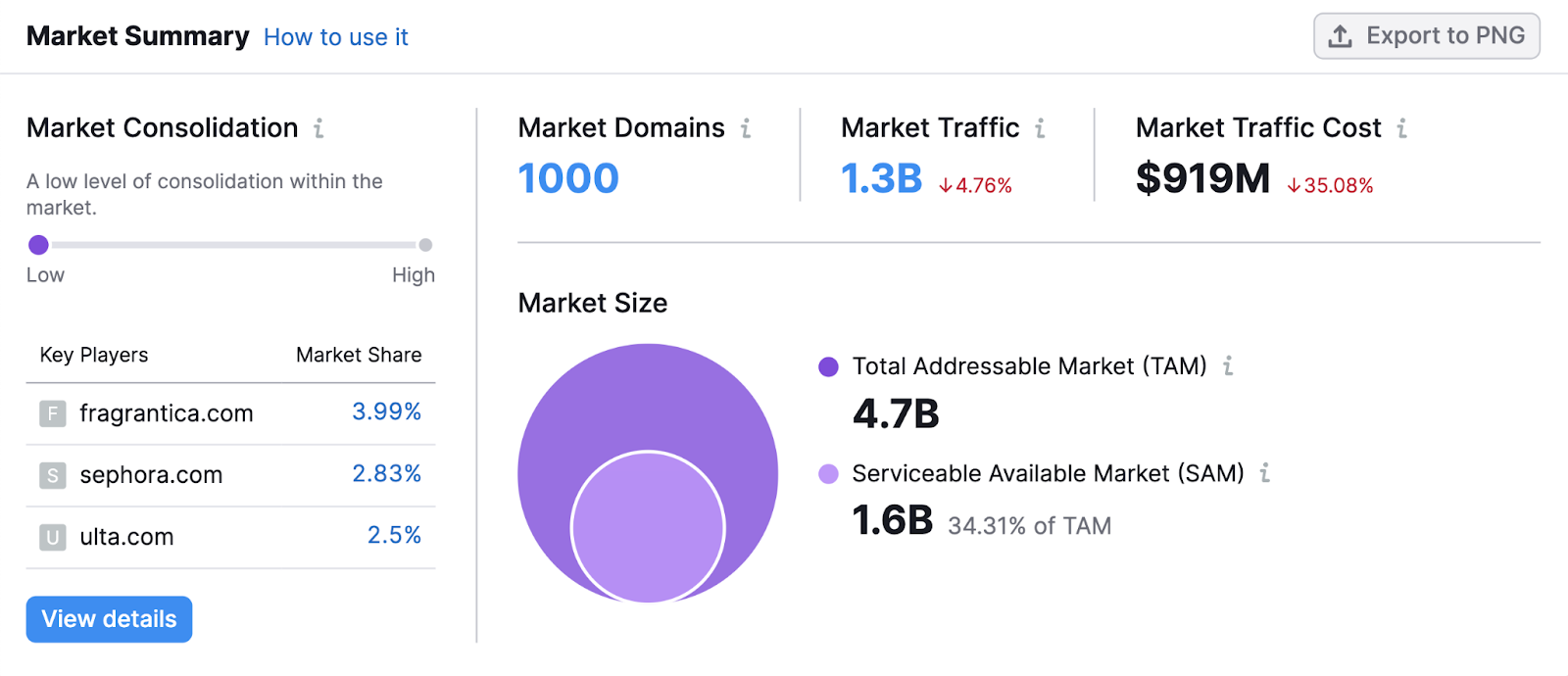
You can also see how an individual domain’s performance compares against the overall market in the “Domain vs Market Dynamics” widget.
Just select a domain you want to evaluate in the left column, and the charts on the right column will automatically adjust.

Use this information to get a sense of the market as a whole.
Further reading: 8 Best Market Analysis Tools (Free & Paid)
3. Assess the Competition
The third step of doing a market analysis is to analyze the competition. To compare between your product or service and other products or services in the market.
Doing this can help you:
- Understand your position within the market
- Identify your competitive advantages and disadvantages
- Learn from your competitors’ best practices and mistakes
And more.
To start, head to Market Explorer again.
This time, select “Find Competitors,” choose a location, enter your domain, and click “Research a market.”

You’ll get a similar dashboard to the previous step. Except this time the tool is analyzing your domain to identify your main competitors.
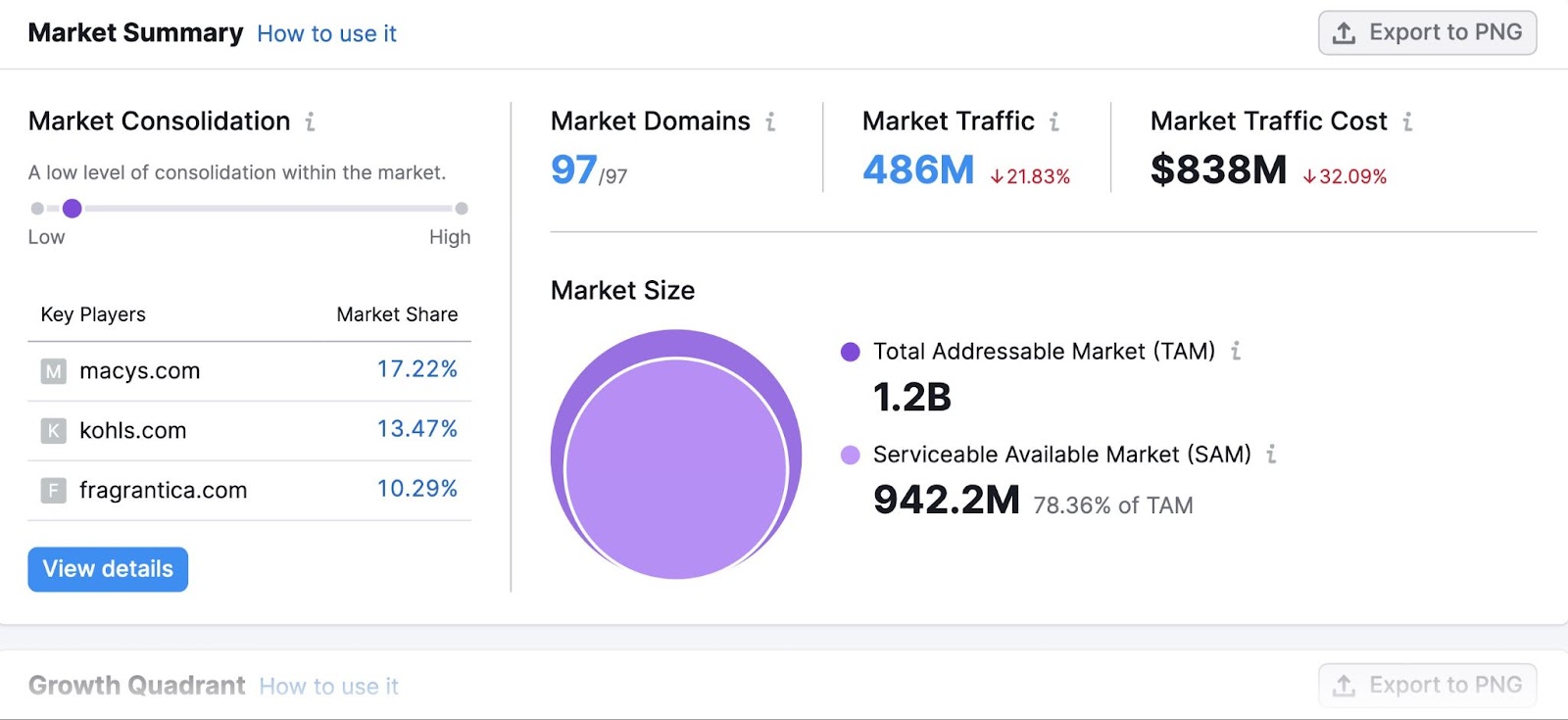
Head to the “Benchmarking” tab.
You’ll see how your site stacks up against your top four competitors regarding traffic volume, acquisition channels, social media networks, and more.
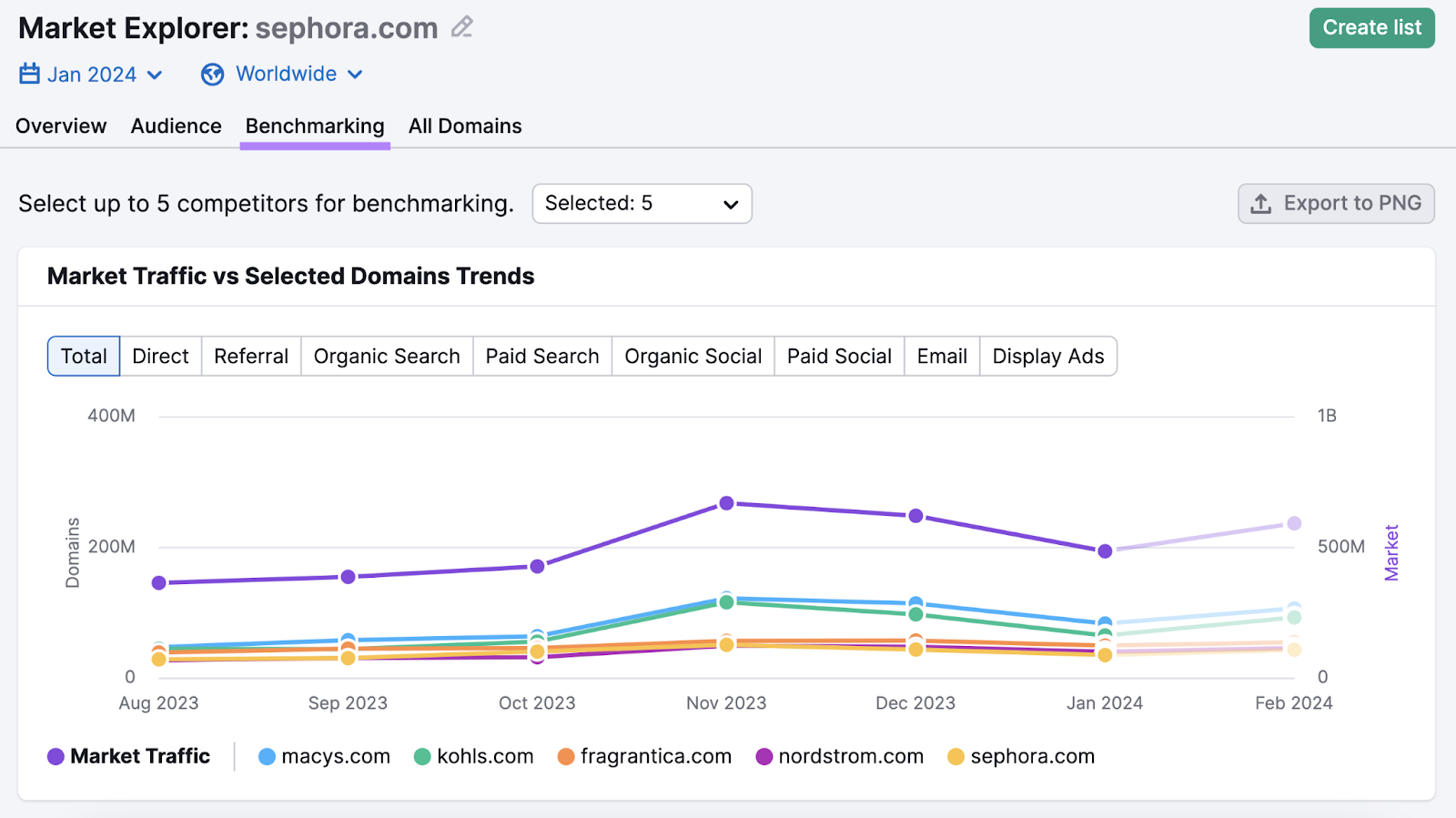
Further reading: What Is a Competitive Analysis & How to Do It (With Template)
4. Identify Your Target Market
Your next step is to identify your target audience—the specific group of potential customers you want to reach and serve with your product or service.
This step can help you focus your efforts on the most profitable and relevant audiences. And customize your offer to meet their needs and expectations.
To start, use an audience research tool like One2Target.
Enter at least one competitor’s domain and click “Analyze.”
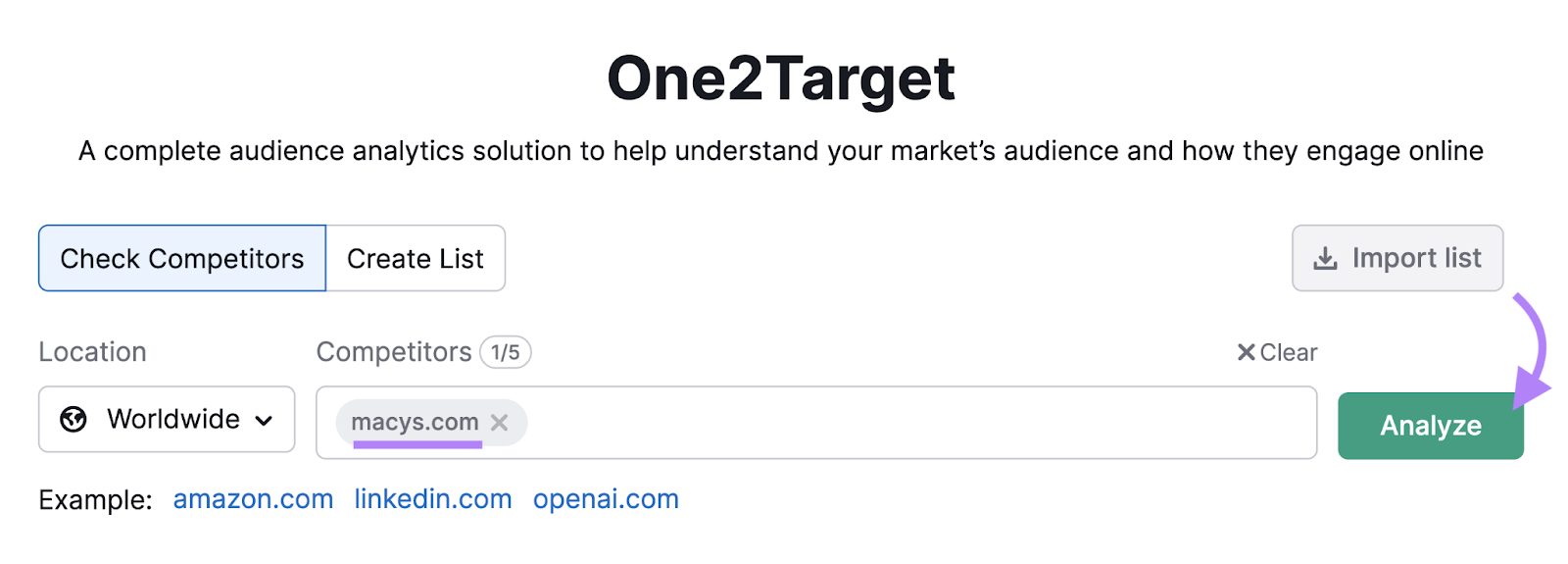
You’ll get information about their audience’s demographic, socioeconomics, online behavior, and more.
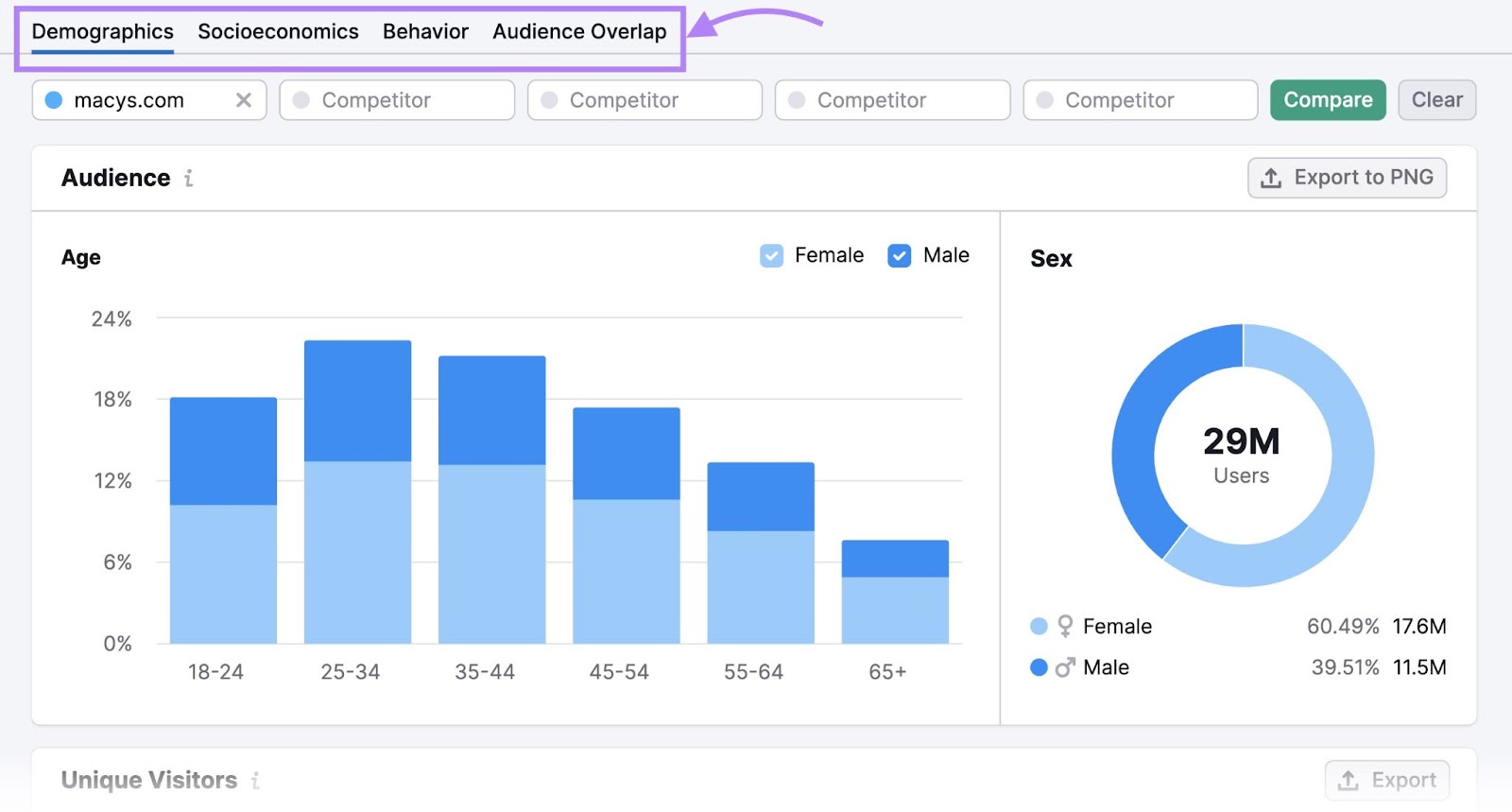
Use these insights to understand who you can potentially reach and how. And tailor your strategy accordingly.
5. Perform a SWOT Analysis
The next step is to perform a strengths, weaknesses, opportunities, and threats (SWOT) analysis.
A SWOT analysis is a strategic tool that helps you evaluate yourself in each of these areas in relation to your market.
Like this:
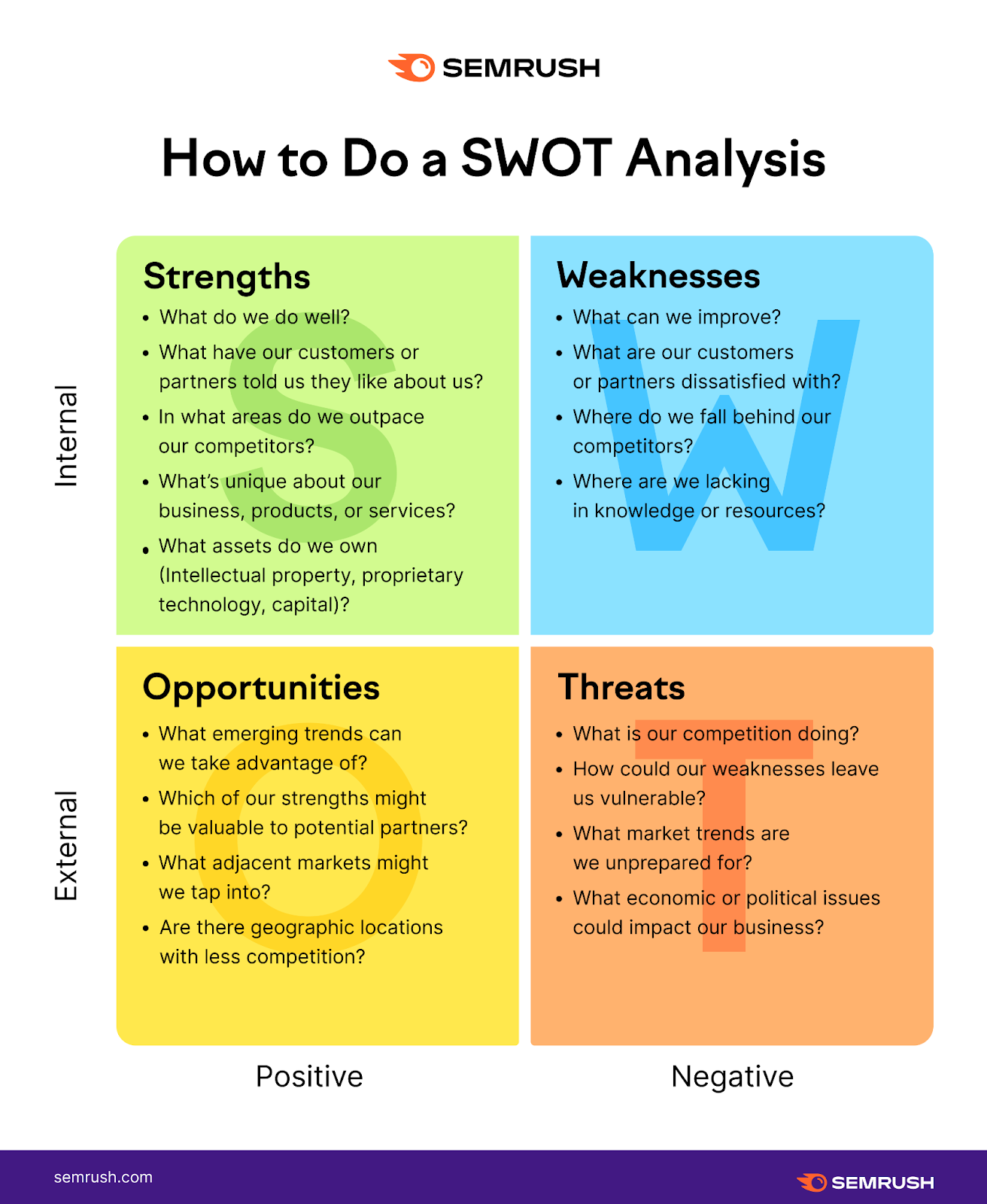
Performing a SWOT analysis can help you identify internal and external factors that affect your market performance. So you can fine tune your strategy.
For example, some common questions to ask yourself in a SWOT analysis are:
- Strengths: What are some advantages that give you an edge? What are you good at? What unique resources do you have?
- Weaknesses: What are the disadvantages that hold you back? Are there any gaps? What are you lacking?
- Opportunities: What trends can you benefit from? What unmet needs or problems can you solve or satisfy? Are there technologies you can leverage?
- Threats: What are some risks in your market? What economic or political issues could impact your business?
This step can help you develop a strategy that responds to the competitive landscape.
6. Put Your Findings to Use
This last step is all about taking everything you learned in your market analysis and applying it to your business.
Remember when we defined goals and objectives?
Here’s where it all comes together.
Make sense of the data you gathered. And use it to make smarter decisions that can help you grow your business.
For example, here are a few ways you can put your findings to work:
- Revise your unique selling proposition
- Consider leveraging different marketing channels
- Adjust your brand positioning and messaging
- Anticipate challenges before they impact you
- Pinpoint areas for improvement in the customer journey
Bear in mind:
This should be a continuous loop of analysis, adjustment, and measurement.
Keep updating your market analysis to reflect changes in the market. To make sure your strategies remain relevant and effective.
Market Analysis Example
Let’s say you are the founder of Pawfect Foods, a startup that produces and delivers high-quality, organic food to pet owners.
You want to analyze your market to validate your business idea and plan your marketing strategy.
Here’s how your marketing analysis might take shape:
Goals and Objectives
Your main goal is to launch your product in the U.S. market and achieve profitable and sustainable growth.
Your objectives are to:
- Increase brand awareness and customer loyalty
- Capture a significant share of the organic food market
- Differentiate your product from competitors by offering superior quality, convenience, and customer service
Market Research Results
You find a report saying the global organic pet food market size was valued at $8.6 billion in 2023 and is expected to grow at a compound annual growth rate (CAGR) of 9.3% from 2022 to 2028.
And it notes the U.S. is the largest market for organic pet food—accounting for 40% of the global revenue in 2023.
The key drivers for market growth are:
- Increasing consumer awareness and preference for natural and organic products for their pets
- Rising pet ownership and spending on pet care and nutrition
- Growing demand for premium and customized pet food products
- Emerging online distribution channels and subscription-based delivery services
Competitive Assessment
The organic food market is highly competitive and fragmented, with several players offering similar products and services.
Some of your major competitors are:
- The Farmer’s : A direct-to-consumer brand that delivers fresh, human-grade, personalized food to customers’ doors. It’s raised over $100 million in funding and claims to have over 100,000 customers.
- Ollie: Another direct-to-consumer brand that offers fresh, human-grade, customized food delivered to customers’ homes. It’s raised over $50 million in funding and claims to have over 50,000 customers.
- Spot & Tango: A direct-to-consumer brand that provides fresh, human-grade, individually portioned food delivered to customers’ doors. It’s raised over $10 million in funding and claims to have over 10,000 customers.
- Petco: A leading pet retailer that sells a variety of organic and natural food brands, such as Castor & Pollux, Halo, and Newman’s Own—both online and in-store. It has over 1,500 stores and a loyal customer base of over 20 million.
Target Market Overview
Your target market is a segment of pet owners looking for organic, high-quality, and convenient food for their furry friends.
You use demographic, geographic, psychographic, and behavioral criteria to define your target market and determine your target market is pet owners who:
- Are aged 25-45, have a household income of over $75,000, and have a college degree or higher
- Live in urban or suburban areas, where there is a high demand for delivery services and online shopping
- Are health-conscious, environmentally aware, and value quality over price
- Are loyal to their pets, spend a lot on pet care and nutrition, and seek personalized and convenient solutions for their pets’ needs
SWOT Analysis
Here’s the SWOT analysis you put together:
- Strengths
- High-quality, organic, and human-grade ingredients
- Customized and personalized food recipes
- Convenient and eco-friendly packaging and delivery
- Excellent customer service and satisfaction guarantee
- Weaknesses
- High production and delivery costs
- Limited brand recognition and customer base
- Dependence on third-party suppliers and couriers
- Regulatory and legal compliance issues
- Opportunities
- Growing market size and demand for organic pet food
- Increasing online and subscription-based sales channels
- Expanding product portfolio and geographic reach
- Partnering with veterinarians and influencers
- Threats
- Intense competition from existing brands and new entrants
- Price sensitivity and economic downturns
- Customer churn and retention challenges
- Negative publicity and reputation risks
Findings to Use
You draw some conclusions and recommendations for your business strategy.
And decide to:
- Position your product as a premium, organic, and personalized food brand that offers convenience and customer service
- Focus on building your online presence and reputation through your website, blog, social media, and email marketing
- Offer free trials, discounts, referrals, and loyalty programs to attract and retain customers
- Explore new markets and distribution channels to expand your customer base and revenue streams
Ensure Your Market Analysis Is Backed by Data
Data is the fuel that powers your market analysis.
Without it, your analysis is just a collection of assumptions and opinions.
But where do you get the data from?
Market Explorer.
It’s an all-in-one market research tool that can help you get insights into any industry and benchmark yourself against competitors.
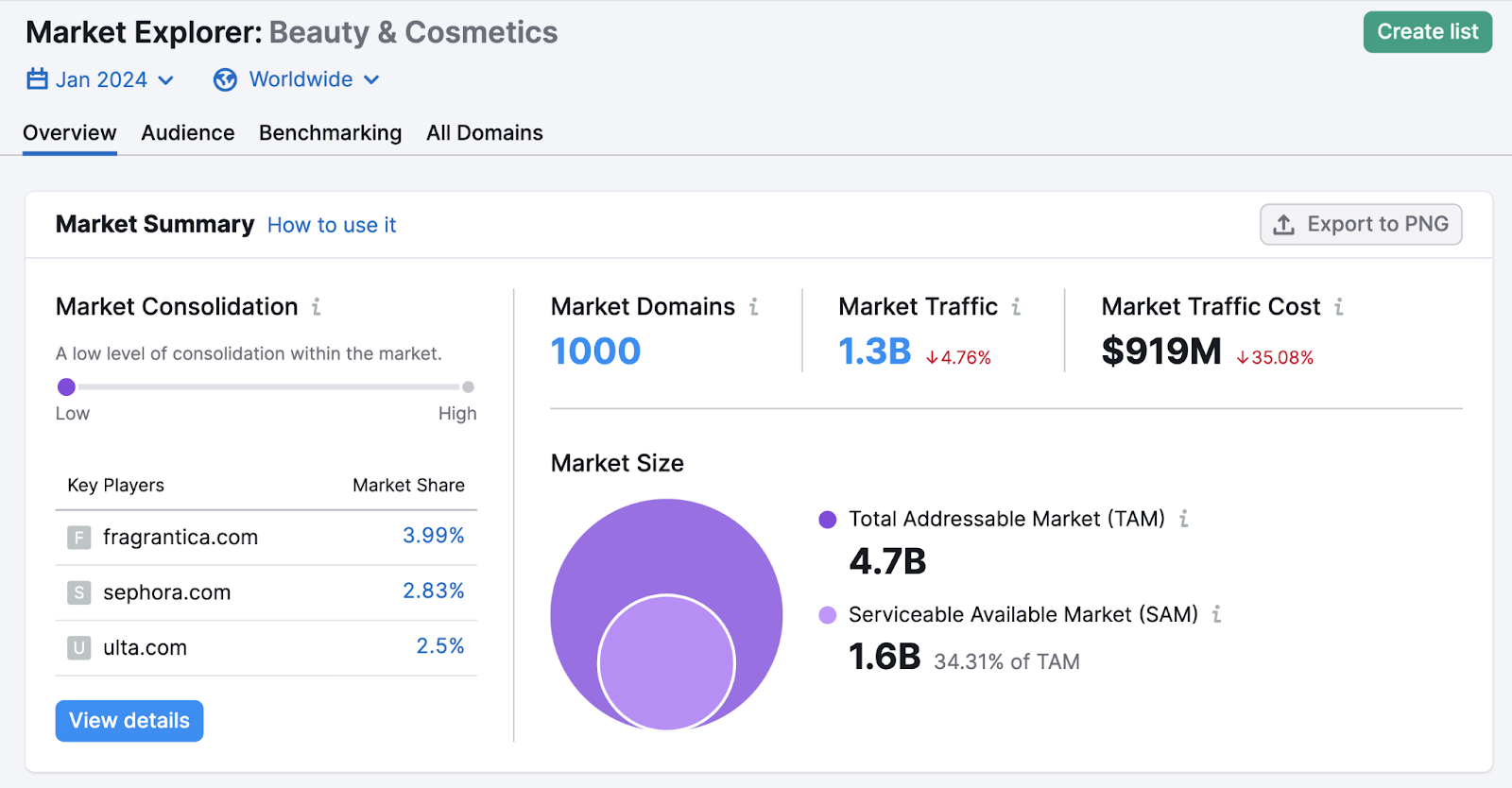
Take the step. And start your first market analysis today.
Source link : Semrush.com
